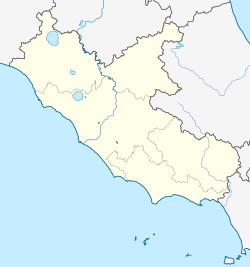Formia is a city in the province of Latina, on the Mediterranean coast of Lazio (Italy). It is located halfway between Rome and Naples, and lies on the Roman-era Appian Way.
Formia | |
|---|---|
| Comune di Formia | |
| Coordinates: 41°16′N 13°37′E / 41.267°N 13.617°E | |
| Country | Italy |
| Region | Lazio |
| Province | Latina (LT) |
| Frazioni | Marànola, Trivio, Castellonorato, Penitro |
| Government | |
| • Mayor | Sandro Bartolomeo (since May 2003) |
| Area | |
• Total | 74.17 km2 (28.64 sq mi) |
| Population | |
• Total | 38,032 |
| Demonym | Formiani |
| Time zone | UTC+1 (CET) |
| • Summer (DST) | UTC+2 (CEST) |
| Postal code | 04023 |
| Dialing code | 0771 |
| Patron saint | St. Erasmus and St. John |
| Saint day | June 2 and June 24 |
| Website | www.comune.formia.lt.it |
History
Formia was founded by ancient Romans, the name deriving from the Greek hormiai, meaning "landing place". It was a renowned resort during the imperial era.
Cicero was assassinated on the Appian Way outside the town in 43 BC, and his tomb remains a minor tourist destination. The city was also the seat of St. Erasmus's martyrdom, by being disemboweled around 303 AD, during the persecutions of Diocletian.
After the fall of the Western Roman Empire the city was sacked by barbarians and the population moved to two distinct burghs on the nearby hill, which were under the rule of Gaeta. Charles II of Anjou built a fortress in the maritime burgh, Mola di Gaeta. The other burgh was known as Castellone, from the castle erected there in the mid-14th century by Onorato I Caetani, count of Fondi.
The two villages were united again in 1863 under the name of Formia.
Main sights
The most famous monument of Formia is the mausoleum traditionally identified with the Tomb of Cicero: it is a 24 m-high tower on the old Appian Way, enclosed in a large (83x68 m) funerary precint.
Other sights include:
- Tower of Castellone
- Roman cistern, one of the world's largest. Similar to the structures in Constantinople and in the Domitian's villa of Albano, it dates from te 1st century BC.
- Remains of the Villa of Mamurra, partly destroyed in 1943, and of Roman aqueducts and cryptoportici.
- Church of San Giovanni Battista e Lorenzo, known from 841. It was almost entirely destroyed during World War II. It houses a panel by Antoniazzo Romano (c. 1490)
- Church of San Luca, known from the 15th century. It has a recently discovered crypt with frescoes of Episodes of the New Testament and Madonna del Latte.
- Renaissance monastery and church of Sant'Erasmo. It was erected on the alleged site of the saint's martyrdom.
- Archaeological Museum.
Sport
Formia is the seat of the National Athletics School of the Italian Olympic Committee, founded in 1955. Athlets such as Pietro Mennea and Giuseppe Gibilisco trained here.
Transportation
Formia itself is a the most important transportation hub of southern Lazio. The Rome-Naples rail line passes through Formia, from which visitors and residents travel by bus to Gaeta, Minturno, Spigno and other local towns.
Twin towns
- Ferrara, Italy
- Fleury-les-Aubrais, France, since 2004
- Gracanica, Bosnia and Erzegovina
- Haninge, Sweden
- Santeramo in Colle, Italy
- ^ "Superficie di Comuni Province e Regioni italiane al 9 ottobre 2011". Italian National Institute of Statistics. Retrieved 16 March 2019.
- ^ "Popolazione Residente al 1° Gennaio 2018". Italian National Institute of Statistics. Retrieved 16 March 2019.


